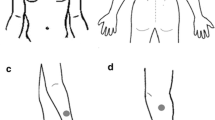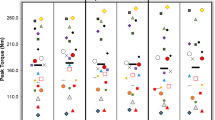Abstract
Purpose
Previous data indicate that a strong sensory input from orally administered TRPV1 and TRPA1 activators alleviates muscle cramps in foot muscles by reducing the α-motor neuron hyperexcitability. We investigated if TRP activators increase the cramp threshold frequency of the medial gastrocnemius.
Methods
We randomly assigned 22 healthy male participants to an intervention (IG) and a control group (CG). While participants of the IG ingested a mixture of TRPV1 and TRPA1 activators, the CG received a placebo. We tested the cramp threshold frequency (CTF), the cramp intensity (EMG activity), and the perceived pain of electrically induced muscle cramps before (pre), and 15 min, 4, 8, and 24 h after either treatment. We further measured the maximal isometric force of knee extensors at pre, 4, and 24 h to assess potential side-effects on the force output.
Results
When we included all measurement time points, no group-by-time interaction was observed for the CTF. However, when only pre and 15 min values were incorporated, a significant interaction, with a slightly greater CTF increase in IG (3.1 ± 1.5) compared to the CG (2.0 ± 1.5), was observed. No significant group by time interaction was found for the cramp intensity, the perceived pain, and the maximal isometric force.
Conclusion
Our data indicate that orally administered TRPV1 and TRPA1 activators exert a small short-term effect on the CTF, but not on the other parameters tested. Future studies need to investigate whether such small CTF increments are sufficient to prevent exercise-associated muscle cramps.


Similar content being viewed by others
Abbreviations
- ANOVA:
-
Analysis of variance
- aRMSA:
-
Average root mean square amplitude
- CG:
-
Control group
- CTF:
-
Cramp threshold frequency
- EAMC:
-
Exercise-associated muscle cramps
- EMG:
-
Electromyography
- IG:
-
Intervention group
- TRPA1:
-
Transient receptor potential cation channel A1
- TRPV1:
-
Transient receptor potential cation channel V1
- VAS:
-
Visual analog scale
References
Alvarez-Berdugo D, Rofes L, Farre R, Casamitjana JF, Enrique A, Chamizo J, Padron A, Navarro X, Clave P (2016) Localization and expression of TRPV1 and TRPA1 in the human oropharynx and larynx. Neurogastroenterol Motil 28(1):91–100. doi:10.1111/nmo.12701
Bandell M, Story GM, Hwang SW, Viswanath V, Eid SR, Petrus MJ, Earley TJ, Patapoutian A (2004) Noxious cold ion channel TRPA1 is activated by pungent compounds and bradykinin. Neuron 41(6):849–857. doi:10.1016/S0896-6273(04)00150-3
Behringer M, Moser M, McCourt M, Montag J, Mester J (2014) A promising approach to effectively reduce cramp susceptibility in human muscles: a randomized, controlled clinical trial. PLoS One 9(4):e94910. doi:10.1371/journal.pone.0094910
Behringer M, Link TW, Montag J, McCourt ML, Mester J (2015) Are electrically induced muscle cramps able to increase the cramp threshold frequency, when induced once a week? Orthop Rev (Pavia) 7(3):6028. doi:10.4081/or.2015.6028
Behringer M, Spieth V, Montag JCK, Willwacher S, McCourt ML, Mester J (2016) Cramp training induces a long-lasting increase of the cramp threshold frequency in healthy subjects. Neuromodulation. doi:10.1111/ner.12525
Bergeron MF (2008) Muscle cramps during exercise—is it fatigue or electrolyte deficit? Curr Sport Med Rep 7(4):S50–S55. doi:10.1249/Jsr.0b013e31817f476a
Craighead DH, Shank SW, Alexander LM, Kenney WL (2016) Orally ingested transient receptor potential (TRP) channel activators attenuate the intensity-duration of voluntarily induced muscle cramps in humans. FASEB J 30(1 Suppl):lb706
Craighead DH, Shank SW, Gottschall JS, Passe DH, Murray B, Alexander LM, Kenney WL (2017) Ingestion of TRP channel agonists attenuates exercise-induced muscle cramps. Muscle Nerve. doi:10.1002/mus.25611
Dale RB, Leaver-Dunn D, Bishop P (2003) A compositional analysis of a common acetic acid solution with practical implications for ingestion. J Athl Train 38(1):57–61
Faul F, Erdfelder E, Lang A-G, Buchner A (2007) G*Power 3: a flexible statistical power analysis program for the social, behavioral, and biomedical sciences. Behav Res Methods 39(2):175–191
Hegarty B, Short G, Bean B, MacKinnon R, Wessel T, Westphal C, Cermak J (2015) TRPV1 and TRPA1 activators reduce muscle cramping. Potential new treatment for MS symptoms. Poster Session 1—P669. Mult Scler J 21(11 Suppl):76–653. doi:10.1177/1352458515602642
Kaufman MP, Hayes SG, Adreani CM, Pickar JG (2002) Discharge properties of group III and IV muscle afferents. Adv Exp Med Biol 508:25–32
Kim Y-S, Hong CS, Lee SW, Nam JH, Kim BJ (2016) Effects of ginger and its pungent constituents on transient receptor potential channels. Int J Mol Med 38(6):1905–1914. doi:10.3892/ijmm.2016.2791
Layzer RB (1994) The origin of muscle fasciculations and cramps. Muscle Nerve 17(11):1243–1249. doi:10.1002/mus.880171102
Martin PG, Weerakkody N, Gandevia SC, Taylor JL (2008) Group III and IV muscle afferents differentially affect the motor cortex and motoneurones in humans. J Physiol 586(5):1277–1289. doi:10.1113/jphysiol.2007.140426
Maughan RJ (1986) Exercise-induced muscle cramp: a prospective biochemical study in marathon runners. J Sports Sci 4(1):31–34. doi:10.1080/02640418608732095
Miller KC, Knight KL (2007) Pain and soreness associated with a percutaneous electrical stimulation muscle cramping protocol. Muscle Nerve 36(5):711–714. doi:10.1002/mus.20857
Miller KC, Knight KL (2009) Electrical stimulation cramp threshold frequency correlates well with the occurrence of skeletal muscle cramps. Muscle Nerve 39(3):364–368. doi:10.1002/mus.21170
Miller KC, Mack GW, Knight KL (2010a) Gastric emptying after pickle-juice ingestion in rested, euhydrated humans. J Athl Train 45(6):601–608. doi:10.4085/1062-6050-45.6.601
Miller KC, Mack GW, Knight KL, Hopkins JT, Draper DO, Fields PJ, Hunter I (2010b) Reflex inhibition of electrically induced muscle cramps in hypohydrated humans. Med Sci Sports Exerc 42(5):953–961. doi:10.1249/MSS.0b013e3181c0647e
Miller KC, Stone MS, Huxel KC, Edwards JE (2010c) Exercise-associated muscle cramps. Causes, treatment, and prevention. Sports. Health 2(4):279–283. doi:10.1177/1941738109357299
Minetto MA, Botter A, Ravenni R, Merletti R, de Grandis D (2008) Reliability of a novel neurostimulation method to study involuntary muscle phenomena. Muscle Nerve 37(1):90–100. doi:10.1002/mus.20903
Nelson NL, Churilla JR (2016) A narrative review of exercise-associated muscle cramps: factors that contribute to neuromuscular fatigue and management implications. Muscle Nerve 54(2):177–185. doi:10.1002/mus.25176
Okun M, Lampl I (2008) Instantaneous correlation of excitation and inhibition during ongoing and sensory-evoked activities. Nat Neurosci 11(5):535–537. doi:10.1038/nn.2105
Roper SD (2014) TRPs in taste and chemesthesis. Handb Exp Pharmacol 223:827–871. doi:10.1007/978-3-319-05161-1_5
Sailer A, Molnar GF, Cunic DI, Chen R (2002) Effects of peripheral sensory input on cortical inhibition in humans. J Physiol 544(2):617–629. doi:10.1113/jphysiol.2002.028670
Schwellnus MP (2009) Cause of exercise associated muscle cramps (EAMC)—altered neuromuscular control, dehydration or electrolyte depletion? Br J Sports Med 43(6):401–408. doi:10.1136/bjsm.2008.050401
Schwellnus MP, Derman EW, Noakes TD (1997) Aetiology of skeletal muscle ‘cramps’ during exercise. A novel hypothesis. J Sports Sci 15(3):277–285. doi:10.1080/026404197367281
Schwellnus MP, Nicol J, Laubscher R, Noakes TD (2004) Serum electrolyte concentrations and hydration status are not associated with exercise associated muscle cramping (EAMC) in distance runners. Br J Sports Med 38(4):488–492. doi:10.1136/bjsm.2003.007021
Short G, Hegarty B, MacKinnon R, Bean B, Westphal C, Cermak J (2015) Orally-administered TRPV1 and TRPA1 activators inhibit electrically-induced muscle cramps in normal healthy volunteers (S17.003). Neurology 84(14 Suppl)
Sidhu SK, Weavil JC, Mangum TS, Jessop JE, Richardson RS, Morgan DE, Amann M (2017) Group III/IV locomotor muscle afferents alter motor cortical and corticospinal excitability and promote central fatigue during cycling exercise. Clin Neurophysiol 128(1):44–55. doi:10.1016/j.clinph.2016.10.008
Stange K (1970) Transformation einer schiefen Verteilung in eine Normalverteilung. In: Angewandte Statistik. Erster Teil Eindimensionale Probleme. Springer, Berlin, Heidelberg, pp 340–356. doi:10.1007/978-3-642-85602-0_10
Stone MB, Edwards JE, Babington JP, Ingersoll CD, Palmieri RM (2003) Reliability of an electrical method to induce muscle cramp. Muscle Nerve 27(1):122–123. doi:10.1002/mus.10296
Stone MB, Edwards JE, Huxel KC, Cordova ML, Ingersoll CD, Babington JP (2010) Threshold frequency of an electrically induced cramp increases following a repeated, localized fatiguing exercise. J Sports Sci 28(4):399–405. doi:10.1080/02640410903508854
Sulzer NU, Schwellnus MP, Noakes TD (2005) Serum electrolytes in Ironman triathletes with exercise-associated muscle cramping. Med Sci Sports Exerc 37(7):1081–1085
Wang YY, Chang RB, Allgood SD, Silver WL, Liman ER (2011) A TRPA1-dependent mechanism for the pungent sensation of weak acids. J Gen Physiol 137(6):493–505. doi:10.1085/jgp.201110615
Williams RB, Conway DP (2000) Treatment of acute muscle cramps with pickle juice: a case report [abstract]. J Athl Train 35(Suppl 2):S24
Yang F, Xiao X, Cheng W, Yang W, Yu P, Song Z, Yarov-Yarovoy V, Zheng J (2015) Structural mechanism underlying capsaicin binding and activation of the TRPV1 ion channel. Nat Chem Biol 11(7):518–524. doi:10.1038/nchembio.1835
Author information
Authors and Affiliations
Corresponding author
Ethics declarations
Conflict of interest
The investigated mixture of TRP-activators was made available to us free of charge by Flex Pharma INC. (Boston, MA, USA). The manufacturer had no role in study design, data collection and analysis, decision to publish, or preparation of the manuscript. This research received no grant from any funding agency in the public, commercial, or not-for-profit sectors.
Additional information
Communicated by Fabio Fischetti.
Rights and permissions
About this article
Cite this article
Behringer, M., Nowak, S., Leyendecker, J. et al. Effects of TRPV1 and TRPA1 activators on the cramp threshold frequency: a randomized, double-blind placebo-controlled trial. Eur J Appl Physiol 117, 1641–1647 (2017). https://doi.org/10.1007/s00421-017-3653-6
Received:
Accepted:
Published:
Issue Date:
DOI: https://doi.org/10.1007/s00421-017-3653-6




